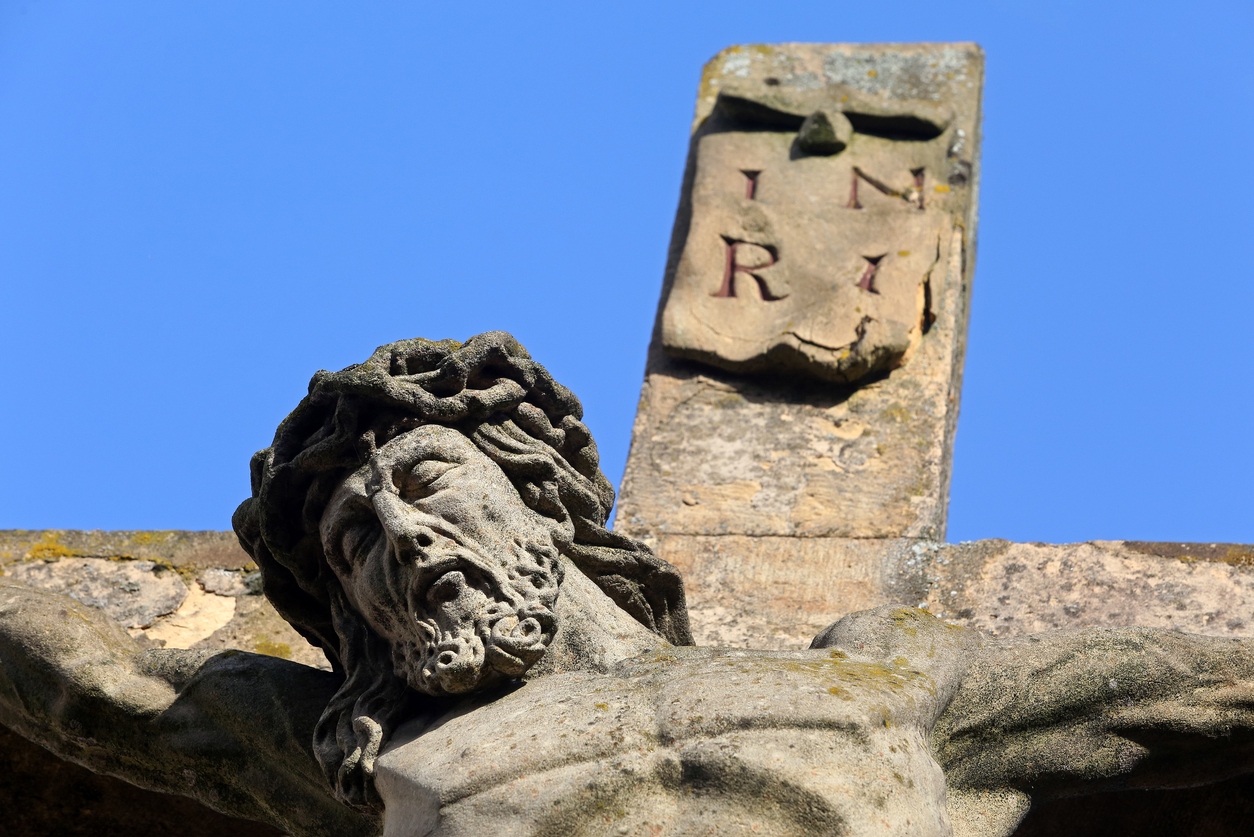
The Titulus Crucis
On February 1, 1492, a section of the titulus crucis was discovered at the Basilica of Santa Croce in Rome. This placard is believed to be from the tablet placed above Jesus’ head on the True Cross. One side has the inscription “Jesus of Nazareth, King of the Jews,” written in Hebrew, Greek, and Latin. How did this most holy relic come to be found tucked away in an Italian church 1,450 years after Jesus’ crucifixion?
Let’s trace the route from Jerusalem to Rome starting with its origin. During Jesus’ time, advertising the reason for a death sentence was a common Roman practice. Pontius Pilate, upon condemning Jesus to death, ordered a placard made. We know of its existence because the titulus is mentioned in the gospels of John, Matthew, and Mark. (See Jn 19:19–22; Mt 27:37; Mk 15:26). What happened to it after the Crucifixion? As Jesus was being removed from the cross-beam, the titulus was tossed into the nearby cistern, used as an accustomed garbage pit. There it stayed for over three hundred years.
After the Roman Emperor Hadrian suppressed the bar Cocheba Revolt of 132–135 A.D., he expelled all Jews from Jerusalem and ordered a new city, Aelia Capitolina, built over it. Golgotha, where the Crucifixion occurred, and the nearby tombs, where Jesus was brought after his death, were buried under Hadrian’s new structures. Two hundred years later, in AD 325, Constantine the Great’s mother, Helena, came to Jerusalem on a holy pilgrimage. The temple to Venus that Hadrian had erected was removed, revealing three tombs. The middle tomb was identified as Jesus’ sepulcher.
How did Helena know which tomb was Jesus’? The Jerusalem church had never ceased to exist, though it had left the walled city before Titus’ siege that culminated in the destruction of Jerusalem in AD 70. We may be confident that the location and description of Jesus’ tomb, the holiest spot in the world to Christians, was passed down through generations as the tradition of that parish. Hadrian unintentionally flagged the location of the tomb by building the temple to Venus over it; graffiti of the period of Hadrian’s temple prove the site was an object of Christian pilgrimage even before Helena. Similarly, he flagged the location of Golgotha by erecting a statue of Jupiter over it.
Helena had the abandoned cistern cleaned out in a search for relics related to the Crucifixion. The titulus, the sign above Jesus’ head on the cross, was found. Helena had it cut up and distributed among the two capitals of the Empire, Rome and Constantinople, and the Holy City, Jerusalem. The latter two pieces have been destroyed or lost, the Jerusalem piece having been carried into battle by the Crusaders and burned by the Moslems.
The portion of the titulus sent to Rome was housed in a chapel Helena built inside her palace. In 846 the Moslems sacked St. Peter’s, as well as St. Paul’s Outside the Walls, and the walled remnants of Rome itself were in peril. At that time the titulus was hidden and left there for a long enough time in fear of another Moslem invasion that those who knew its hiding place obviously died without being able to pass on the secret of its location. It was discovered during a restoration in 1492. The Basilica of Santa Croce of Gerusalemme (the Holy Cross in Jerusalem) now stands where Helena built her chapel and includes Rome’s fragment of the titulus.
Naturally, there exists some doubt as to the authenticity of the titulus crucis. Some believe it to be the original placard and others suspect it is a medieval copy. However, epigraphical studies and examination of the titulus have established that it is of a type of wood found near Jerusalem and that the writing style is appropriate to the first century AD. The portions of Hebrew, Greek, and Latin text on the titulus provide a clue to its origin. The workman who carved the letters on the placard was obviously a Jew with little knowledge of Greek or Latin. The Greek and Latin inscriptions are carved like the Jewish inscription, from right to left. If the titulus were a forgery, that would be an error obviously avoided. Likewise, if it were a forgery the languages would have been in the order given by John—that is, Hebrew, Latin, and Greek instead of Hebrew, Greek, and Latin. (Jn 19:20) If it is genuine, as I believe, it shows the hasty work of a Jewish workman far down the pay scale, the sort one would expect to have been given this particular task.
The significance of the titulus crucis cannot be understated. For Christians everywhere, it reminds us that Jesus died for us. Whenever we see INRI, the acronym for the Latin translation of Jesus (Iesvs) of Nazareth (Nazarenvs), King (Rex) of the Jews (Iudaeorvm), we remember that it was he who brought about our salvation.
NOTE: The Basilica of Santa Croce in Gerusalemme is part of the route of the “Seven Pilgrim Churches” in Rome. The other churches are St. Peter’s Basilica, Basilica of Saint Paul Outside-the-Walls, Basilica of St. John Lateran, Basilica of St. Mary Major, Basilica of St. Lawrence Outside-the-Walls, and the Sanctuary of Our Lady of Divine Love, which replaced St. Sebastian Outside-the-Walls on the pilgrimage route in 2000.
